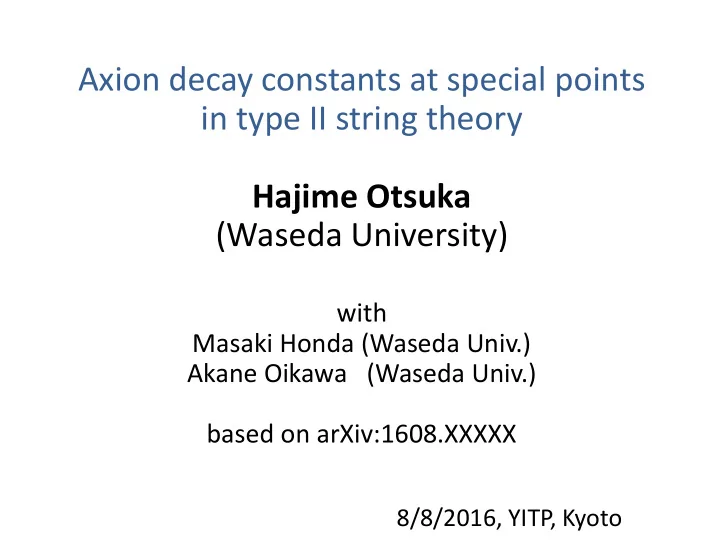

Axion decay constants at special points in type II string theory Hajime Otsuka (Waseda University) with Masaki Honda (Waseda Univ.) Akane Oikawa (Waseda Univ.) based on arXiv:1608.XXXXX 8/8/2016, YITP, Kyoto
Axion ○ Solution of the strong CP problem ① ② ① The candidate of dark matter (“QCD axion window”) ② Successful axion inflation (natural inflation etc.)
Axions in string theory A lot of axions originating from high-dimensional form fields: e.g. ○ Integrating the 2-form 𝐵 over the internal 2-cycle Σ of internal manifold, Σ 𝒋 𝑏 𝑗 𝑦 = Σ 𝑗 𝐵 2-form Axions Perturbative flat potential (shift symmetry) ○ Gauge symmetry: 𝐵 → 𝐵 + 𝑒Λ becomes a shift symmetry for 𝑏 𝑗 𝑦 , 𝑏 𝑗 𝑦 → 𝑏 𝑗 𝑦 + const. ○ Some non-perturbative effects generate their potential.
Axion decay constant in string theory Axion Decay constant associated with the volume modulus: : Kähler metric of volume modulus is the Kähler potential in the large volume limit : Calabi-Yau volume : reduced Planck mass Typical decay constant of closed string axion: K. Choi and J. E. Kim, (’85); T. Banks, M. Dine, P. J. Fox, and E. Gorbatov (’03); P. Svrcek and E. Witten, (’06).
Axion decay constant in string theory However, when the visible sector lives on the localized cycle, the value of gauge coupling in the visible sector Is irrelevant to the volume of CY. Large cycle Small cycle (visible sector) Tiny axion decay constant V. Balasubramanian, P. Berglund, J. P. Conlon, and F. Quevedo, JHEP, 03:007, 2005. The string scale is simultaneously small. : string coupling
○ How about the other closed string axion in type IIB string? In particular, axions associated with complex structure moduli Its decay constant will be irrelevant to the string scale. Cosmology and phenomenology of complex structure moduli. Axion inflation with CS moduli (Oikawa-san poster)
Axions associated with the complex structure (CS) moduli The Kähler potential for CS moduli (z) in type IIB string on CY: : Symplectic matrix Period vector over the three-cycles: : holomorphic three-form
Axions associated with the complex structure (CS) moduli Under the monodromy trf. around the special point , Kähler potential is invariant. : Monodromy trf. matrix Such symmetries of the Kähler potential induces the existence of axions. Axions naturally appear in the low-energy effective theory.
Picard-Fuchs (PF) equations for one-parameter CY manifolds The period vector is obtained by solving the PF eq. We focus on the 14 CY manifolds defined in (weighted) projective space. Y. -H. Chen, Y. Yang and N. Yui, J. Reine Angew (‘08) (E.g., Mirror Quintic CY manifold This class of PF eq. can be solved by using Meijer G function. B. R. Greene and C. I. Lazaroiu (’01).
“Special points”: regular singular points of PF eq. We focus on the several special points of moduli space. i) Small complex structure (SCS) point ( ) ii) Conifold point ( ) iii) Large complex structure (LCS) point ( ) LCS SCS conifold
Kähler potential around the SCS point( ) In all cases, axion (arg(z)) appears around the SCS point. : LCM of the degree of polynomials
Axion decay constant around the SCS point In all cases, massless axion (arg(z)) appears around the SCS point. There is a continuous shift symmetry, arg(z) → arg(z) +const. The axion Kähler metric vanishes at the SCS point( ). Tiny axion decay constant is realized around the SCS point. Note that the case with is physically equivalent to the LCS point. (PF eq. around the SCS point is related to that around the LCS)
Axion decay constant around special points In a similar fashion, we find that the axion decay constant vanishes at all the special points. LCS conifold SCS When the CS modulus is stabilized around the special points, we can realize the tiny axion decay constant. Axion associated with the complex structure modulus can be identified with the QCD axion.
Massless axion and moduli stabilization Procedures to stabilize the CS modulus around the SCS point: We redefine the CS modulus as . Kähler potential: Non-perturbatively generated superpotential: : Dilaton : Kähler moduli F-term scalar potential: Uplifting potential induced by the anti D-brane:
Massless axion and moduli stabilization Total scalar potential: By assuming the following condition (as in the KKLT scenario), The extremal condition of CS leads to the VEV of CS, Along the above procedure, we obtain the massless axion. Other moduli fields are stabilized by the superpotential.
Massless axion and moduli stabilization E.g., for CY manifold defined in is achieved under Thus, decay constant of massless axion is much smaller than the string scale. So far, we have assumed the tiny value of . It is interesting and challenging issue to identify the specific form of , since it depends on the detailed D-brane setup.
Conclusion We study the decay constant of closed string axion around the special points of moduli space in type II string on one-parameter CY manifolds. Tiny axion decay constant can be realized around all the special points (SCS, conifold and LCS points). We also propose the moduli stabilization leading to the phenomenologically favorable QCD axion.
Appendix
PF eq. 14 CY manifolds defined in weighted projective space.
PF eq. 14 CY manifolds defined in weighted projective space.
Meijer G function:
Recommend
More recommend